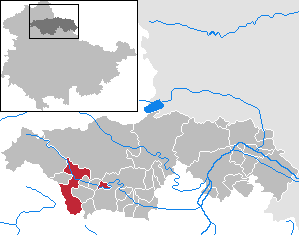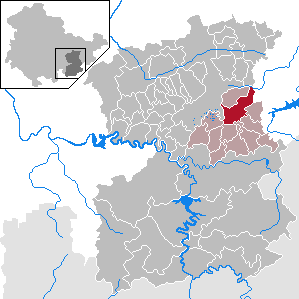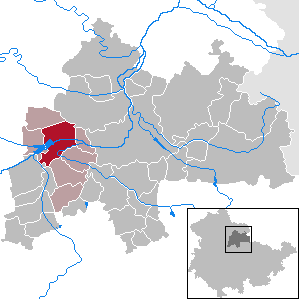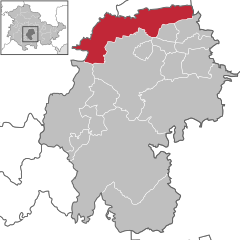
Dingelstädt is a town in the district of Eichsfeld in Thuringia, Germany. It is situated on the upper course of the river Unstrut, 8 km (5 mi) south of Leinefelde-Worbis and 15 km (9 mi) northwest of Mühlhausen. The former municipalities Helmsdorf, Kefferhausen, Kreuzebra and Silberhausen were merged into Dingelstädt in January 2019. In January 2023 Dingelstädt absorbed the villages Bickenriede and Zella from the former municipality Anrode, and Beberstedt and Hüpstedt from the former municipality Dünwald. In January 2024 it absorbed the village Struth from the former municipality Rodeberg.

Bad Sulza is a town in the Weimarer Land district, in Thuringia, Germany. It is situated on the river Ilm, 15 km southwest of Naumburg, and 18 km north of Jena.

Ebeleben is a town in the Kyffhäuserkreis district, in Thuringia, Germany. It is situated 13 km southwest of Sondershausen. The former municipality Thüringenhausen was merged into Ebeleben in December 2019.

Kindelbrück is a municipality in the district of Sömmerda, in Thuringia, Germany. It is situated on the river Wipper, 12 km north of Sömmerda. The former municipalities Bilzingsleben, Frömmstedt and Kannawurf were merged into Kindelbrück in January 2019. In January 2023 Kindelbrück absorbed the former municipality Riethgen.

Königsee is a town and a municipality in the district of Saalfeld-Rudolstadt, in Thuringia, Germany. It is situated 12 kilometres (7.5 mi) east of Ilmenau, and 35 kilometres (22 mi) south of Erfurt. The present municipality was formed on 31 December 2012 by the merger of the former municipalities Königsee and Rottenbach, under the name Königsee-Rottenbach. On 1 January 2019 the former municipalities Dröbischau and Oberhain were absorbed, and the name was changed to Königsee.

Dittersdorf is a municipality in the district Saale-Orla-Kreis, in Thuringia, Germany. On 1 December 2010 it absorbed the former municipality Dragensdorf.

Georgenthal is a municipality in the district of Gotha, in Thuringia, Germany. The former municipalities Leinatal, Hohenkirchen and Petriroda were merged into Georgenthal in December 2019. The former municipality Herrenhof was merged into Georgenthal in January 2024.

Ilmtal-Weinstraße is a municipality in the district Weimarer Land, in Thuringia, Germany. It was named after the river Ilm, that flows through the municipality. It was formed on 31 December 2013 by the merger of the former municipalities Liebstedt, Mattstedt, Niederreißen, Niederroßla, Nirmsdorf, Oberreißen, Oßmannstedt, Pfiffelbach and Willerstedt. Before, these municipalities had cooperated in the Verwaltungsgemeinschaft Ilmtal-Weinstraße, which was disbanded. The seat of the municipality and of the former Verwaltungsgemeinschaft is in Pfiffelbach. The former municipalities Kromsdorf, Rohrbach and Leutenthal were merged into Ilmtal-Weinstraße in January 2019.
Kirchheim is a village and a former municipality in the district Ilm-Kreis, in Thuringia, Germany. Since 1 January 2019, it is part of the municipality Amt Wachsenburg.

Alkersleben is a municipality in the Ilm-Kreis district in Thuringia, Germany. The municipality is a member of the collective municipality Riechheimer Berg.
Ichtershausen is a village and a former municipality in the district Ilm-Kreis, in Thuringia, Germany. Since 31 December 2012, it is part of the municipality Amt Wachsenburg.
Rockhausen is a village and a former municipality in the district Ilm-Kreis, in Thuringia, Germany. Since December 2019, it is part of the municipality Amt Wachsenburg.

Straußfurt is a municipality in the Sömmerda district of Thuringia, Germany. The former municipality Henschleben was merged into Straußfurt in December 2019.

Thörey is a village near Ichtershausen in Ilm-Kreis, Thuringia, Germany, with about 250 inhabitants. It is part of the municipality Amt Wachsenburg.

Wachsenburg Castle is a castle in Amt Wachsenburg in the Ilm-Kreis, Thuringia, Germany. It is one of the Drei Gleichen, three hilltop castles east of Gotha. It was originally built in the 10th century. The castle was extensively reconstructed in the 17th and 19th century. The well-preserved castle now houses a museum, a hotel and a restaurant.

Nessetal is a municipality in the district of Gotha, in Thuringia, Germany. It was created with effect from 1 January 2019 by the merger of the former municipalities of Ballstädt, Brüheim, Bufleben, Friedrichswerth, Goldbach, Haina, Hochheim, Remstädt, Wangenheim, Warza and Westhausen. These former municipalities are now Ortschaften of the municipality Nessetal. The name refers to the river Nesse.

Amt Creuzburg is a town in the Wartburgkreis district, in Thuringia, Germany. It was created with effect from 31 December 2019 by the merger of the former municipalities of Creuzburg, Ebenshausen and Mihla. On 1 January 2024, it absorbed the former municipality Frankenroda. It takes its name from the town Creuzburg, the centre of the new municipality.

Grammetal is a municipality in the Weimarer Land district, in Thuringia, Germany. It was created with effect from 31 December 2019 by the merger of the former municipalities of Bechstedtstraß, Daasdorf am Berge, Hopfgarten, Isseroda, Mönchenholzhausen, Niederzimmern, Nohra, Ottstedt am Berge and Troistedt, that had previously coöperated in the Verwaltungsgemeinschaft Grammetal. It takes its name from the river Gramme, that flows through the municipality.
Ilm-Kreis II is an electoral constituency represented in the Landtag of Thuringia. It elects one member via first-past-the-post voting. Under the current constituency numbering system, it is designated as constituency 23. It covers the northern and western part of Ilm-Kreis.



















